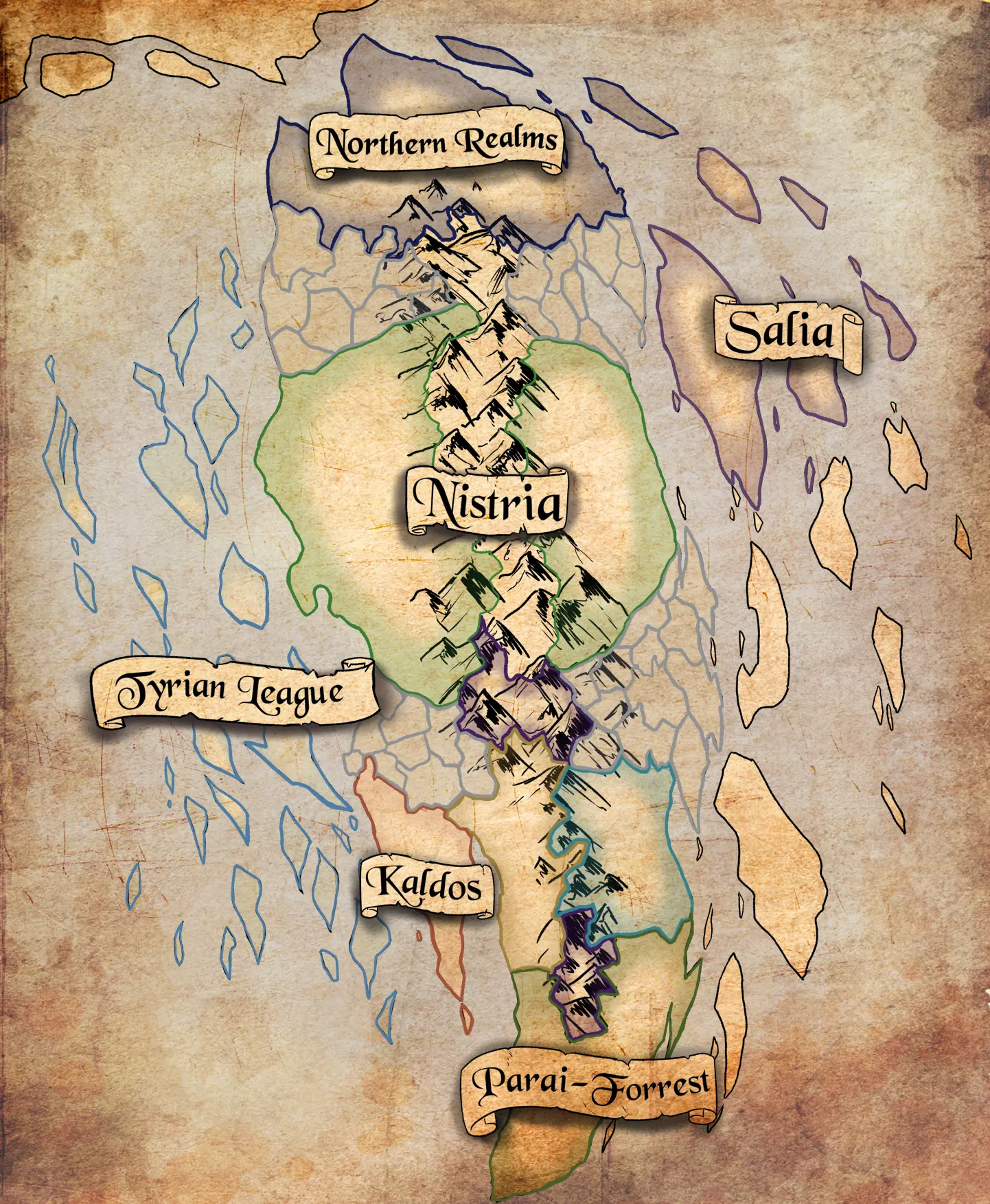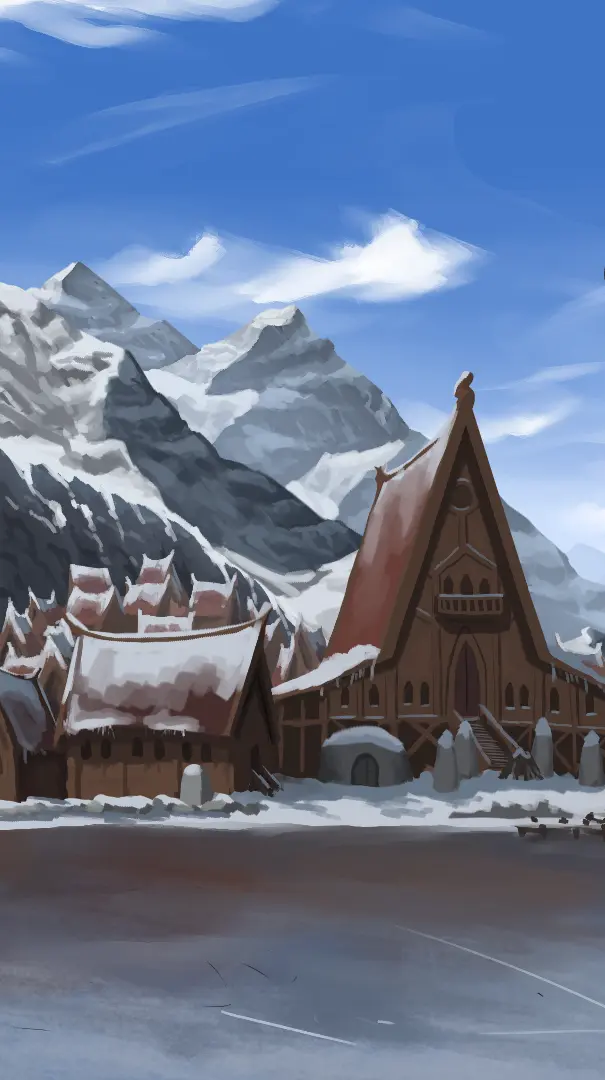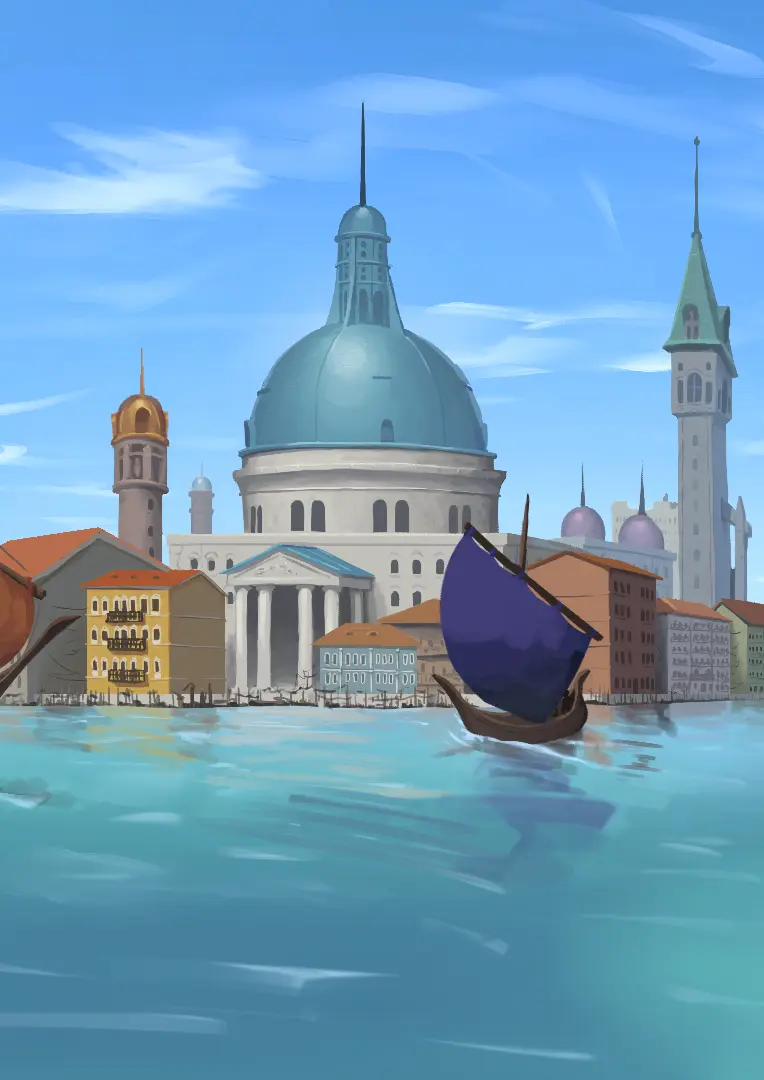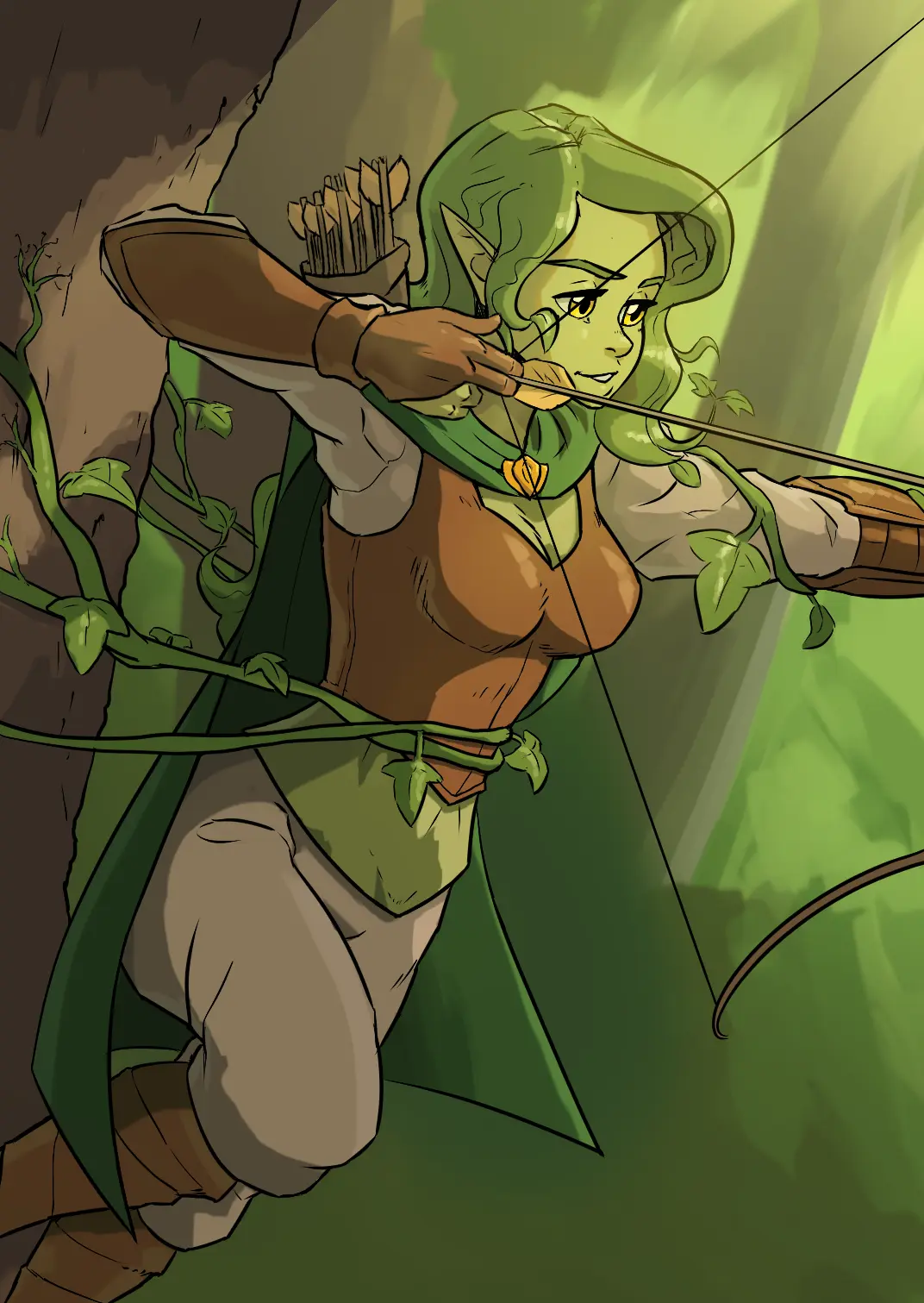The continent of Afrat
Afrat is one of the largest continents of Lysima. It is characterised by huge mountains, vast landscapes and a multitude of species and cultures.
1. Geography
1.1. The Karakaz Mountains

Afrat is divided by the Karakaz Mountains. These mountains are almost impassable along their entire length. They are over 8000 metres high in many parts. The Sky Ripper, the highest mountain in all of Afrat (and perhaps the whole world), reaches a height of 9656 metres.
These stone giants are criss-crossed by ancient tunnels large enough for entire armies to pass through. No one knows who built them. These tunnels are the only way to pass the mountains.
However, the tunnels can be very dangerous. Trade caravans are often lost there without a trace. In rare cases, remains are found, such as in the Rolands Pass Incident. However, these always raise more questions than they answer.
The Dante Pass is both the fastest way through the mountains and the deepest and most dangerous pass of all. It is littered with forks that disappear into the darkness. Only a fraction of them have been mapped and no one knows how deep the tunnels go.
1.2. Climate
The north of Aftrat reaches almost to the North Pole, making it very cold and barren. The northernmost tip is covered by several metres of ice and snow throughout the whole year.
A little further south, the ice sheet gives way to a barren tundra landscape with permafrost soils. The long winter nights and the bitter cold are a special challenge for plants and animals.
The inhabitants here are as harsh as their land. It is difficult to survive here without a pelt. Therefore, most of the inhabitants here are Dyr, who have thick furs to protect them from the cold.
Further south, prolonged warm summers followed by cold winters mean that the cold grey of the northern realms increasingly gives way to a lush green.
The strong east-west wind constantly drives rain clouds against the foothills of the Karakaz Mountains. In eastern Afrat, this leads to long heavy downpours that can last for weeks. In winter, there can be several metres of snow here.
On the west side, however, the wind keeps the rain away and the weather is more moderate. In summer, there are often long dry periods here.
In the centre of Afrat, the west is dominated by its vast lush grasslands, while the east is dominated by mixed and deciduous forests.
On the way south, you pass through a strip of wet grasslands and swamps. Near the coast here is the town of Hazelheim, which is perpetually covered by a dense green fog, poisonous to all but the Bleiksprut. This is just one of the innumerable weather anomalies of which there are countless in Afrat.
The south of Afrat is characterised by tropical weather and regular rain showers. The primeval forest is dominated by the paraian giant, a tree that grows many metres high and whose crown can spread like an umbrella over several kilometres in all directions.
This allows the paraian giant to develop a unique microclimate under its crown, that varies from tree to tree.
This climate diversity provides a home for a vast array of plants and animals.
1.3. The islands around Afrat
Along the entire length of Afrat's coastline are many small and large islands.
The many different currents make for unpredictable dynamics and are treacherous even for experienced sailors.
While many of the islands consist only of rough rock, others are partially or even entirely overgrown with various plants that are often only found on their respective islands.
When travelling through this region, you can see half a dozen islands on the horizon all the time.
2. The Realms of Afrat
The following map is interactive. Click on a realm to get to its summary

2.1. The Northern Realms

The snow-covered north of Afrat is inhabited by the realms of the North. Life there is harsh and vegetation sparse. The inhabitants of this icy cold are well adapted to their environment and have developed a variety of strategies to survive in this hostile landscape.
The majority of the inhabitants known as Nordlings are Dyr, who use their thick fur to defy the merciless cold. However, the adverse circumstances and numerous hardships also ensure, the Norse are widely known for their will to fight and their instinct for survival.
This is also reflected in a multitude of local nature deities, to which the tribesmen dedicate their lives and battles. Especially in winter, when the north tries to suffocate all life in its cold whiteness, the northerners head south to plunder and seek new victims for their bloodthirsty rituals.
2.2. Salia
Salia is located on a group of islands northeast of Afrat. While the land masses are covered by an extremely diverse mixed forest, the oceans are covered by dense coral and kelp forests.
Both the lands and the seas around Salia are inhabited by various Tipu. Although all Tipu here have a very close relationship with the magical primal forces of Salia, the water-tipu and land-tipu factions have been locked in an eternal conflict for centuries over the resources of the islands.
Even though the sea is very wide, the water faction (also called Ngaru) can only find enough shallow areas to live near the islands. They therefore use their water magic, unleashing the unbridled power of the sea to erode Salia's land mass piece by piece.
The land dwellers (also called Haruru) create new land masses with the help of earth magic, either by creating new islands or by triggering controlled volcanic activity.
As a result of this conflict, the Tipu Salias have mages powerful enough to trigger massive tsunamis or volcanic eruptions.
The battles are mostly fought along the coastline. Therefore, it is extremely dangerous here for outsiders. Traders who stray into the region risk being attacked by patrols or having their ships caught in the algae nets or coral reefs. They can also quickly end up between the fronts of a battle, where literal forces of nature collide.
As long as the Ngaru and the Hararu fight with each other, they pose no threat to the rest of Afrat, but it remains to be seen what will happen if the two factions do one day join forces.
2.3. The Nistrian Empire
Nistria, with its considerable size, occupies a substantial part of Central Afrat. It owes its enormous power to its deep veneration of science and technology.
At the head of the country sit the six Archmagisters, who are appointed by the six faculties of the Nistrian Academy. Under this Archmagister Council sits a vast bureaucratic apparatus, which distributes resources across the country, collects information from far beyond its borders and commands the huge military apparatus.
Nistria owes its supremacy on the continent to its focus on technical development and an elite dedicated to science. Through its technological superiority, the inhabitants of this country make up for their physical disadvantages against their non-human enemies.
A particularly important role in this is played by the powerful combat apparatus and massive airships that form the backbone of the Nistrian military. The same technology is also used in the civilian sector, for example to help traders transport goods or farmers cultivate their fields.
The huge amount of resources needed to run the machines comes from the massive industrial complex on Afrat and the ever-growing colonies in Mefos.
For more Info on Nistria, click hier.
2.4. The Small Kingdoms
A number of smaller kingdoms border Nistria to the north and south.
These, often called petty kingdoms, are mostly ruled by Dyr. Many of these Dyr have lost their homes due to Nistria's expansion and were forced to flee to the north or south.
However, most kingdoms are very selective about the creatures they take in. This leads to growing tensions between the kingdoms. Although there have often been efforts in the past to form a united front against Nistria, these have always failed due to internal disputes.
Nistria's direct neighbours in particular live in constant fear, that they will be conquered next. This means that they have to be especially cautious in negotiations, to make sure not to annoy Nistria unnecessarily.
Nistria's bogged-down bureaucratic apparatus and the change of focus on its colonies have effectivelly gound their expansion to a halt over the last hundred years.
However, it seems to take only a small spark to reignite this conflict.
2.5. The Tyrian League

Many important trade routes run through the Tyrian Sea, supplying the west coast of Afrat with important resources and goods.
However, the huge transports of goods through this region inevitably attracted the attention of robbers and pirates. As the problem of piracy began to seriously threaten the existence of the island kingdoms, the greatest merchants and trading nations came together and formed the Tyrian League to fight off the pirates together. Today, this alliance extends over thousands of islands.
The league is governed by a council of the eleven most powerful Doges of the league. Money is the only value on which the (often competing) council members can agree on. Nominations and votes for a seat on the council are therefore mainly a question of money.
Membership not only brings great fame, but also allows the member to exploit the power of the league for personal profits.
The composition of the council changes frequently because council members die unexpectedly or are forced to resign voluntarily, e.g. because they have suffered heavy business losses. Vacant council seats seldom remain unoccupied for long, as a whole range of up-and-coming merchant moguls can be found who are willing to take the vacant seat, even at the cost of enormous wealth.
Even outside the council, wealth is the most important influence on social standing. Tyrian merchants are known to be willing to sell their own mother to their worst enemy as long as they expect to make a profit.
Things unrelated to money and power do not matter much to many Tyrians.
2.6. Gar'Bul
Gar'Bul stretches across the southern foothills of the Karakaz Mountains and is mainly administered by the An'Hem sect. The sect's followers live in smaller monasteries and settlements spread over thousands of mountain flanks.
The prophetess An'Hem, who gave the sect its name, is said to have once found the path to enlightenment on the top of a mountain in the Karakaz Mountains.
Since then, her followers have been searching for said path on the various peaks. In preparation for their often death-bringing ascent, the followers spend their time in the various monasteries to prepare themselves physically and mentally for their journey. Most of the monks develop impressive climbing skills and learn to cope very well with the thin air at the higher altitudes.
However, this is often not enough and many of the mountain peaks remain unreached. This does not stop the new recruits from training even harder. They see the failure of their predecessors as proof that they were still too weak.
Flying creatures who claim that there is nothing interesting at the top of the mountains, are either ignored or driven away. Many cultists are also firmly convinced for this reason, that only by climbing on foot can the path to enlightenment be revealed and the flying beings are sent by An'Hem's adversaries to distract them from the ascent.
2.7. Kaldos
Kaldos is located on a peninsula to the southwest of Afrat, and is controlled by the Kaldera Cartel.
The Kaldera Cartel is considered the largest and most influential cartel in all of Afrat. A thriving black market and a foreign policy based primarily on blackmail and contract killings have made Kaldos one of the most powerful states on the Tyrian Sea.
Through its protection rackets and regular raids on merchant ships in the Tyrian Sea Kaldos is a particular thorn in the side of the Tyrian League. But whenever the League is on the verge of taking active steps against Kaldos, they bribe the right key person or deliberately scales down their actions, until action against Kaldos is stopped because the cost is too high.
In Kaldos, almost everyone can find a home, provided they can defend it against anyone who tries to take it away.
2.8. The Parai Forest

The Parai Forest is a dense jungle that covers the entire southern tip of the continent of Afrat. This forest kingdom is ruled by Tipu, whose habitat extends from the ground to the top of the tallest trees.
The paraian giants, which grow many hundred meters high, create a microclimate of their own due to their enormous size, which allows for a particularly high biodiversity of the tipu.
Other species are also welcome in the Parai forest, as long as they help to maintain this precious habitat. Particularly welcome are creatures that hunt the numerous pests, although there are also some parasitic species among the Tipu. The hunter clans of the Parai Forest use the forest's root network to quickly find and eliminate any threat to the forest.
All plants in the Parai Forest are connected by a gigantic root network to exchange information. Each plant communicates what it perceives through this network, which allows the network to know everything that happens in the forest. This root network contains more knowledge than all of Afrat's libraries combined.
To expand this knowledge, many Tipu act as collectors, gathering information from all over the world. Some try to use their knowledge to enlighten their short-sighted neighbours, which often leads to misunderstandings. For example, an attempt to explain to a ruler that one in fifth of his subjects had to die to avoid famine.
It is also thanks to this radical enlightenment strategy that the representatives of the Parai forest are seen by some as heroes, but by many as harbingers of doom, as their predictions tend to become true.
